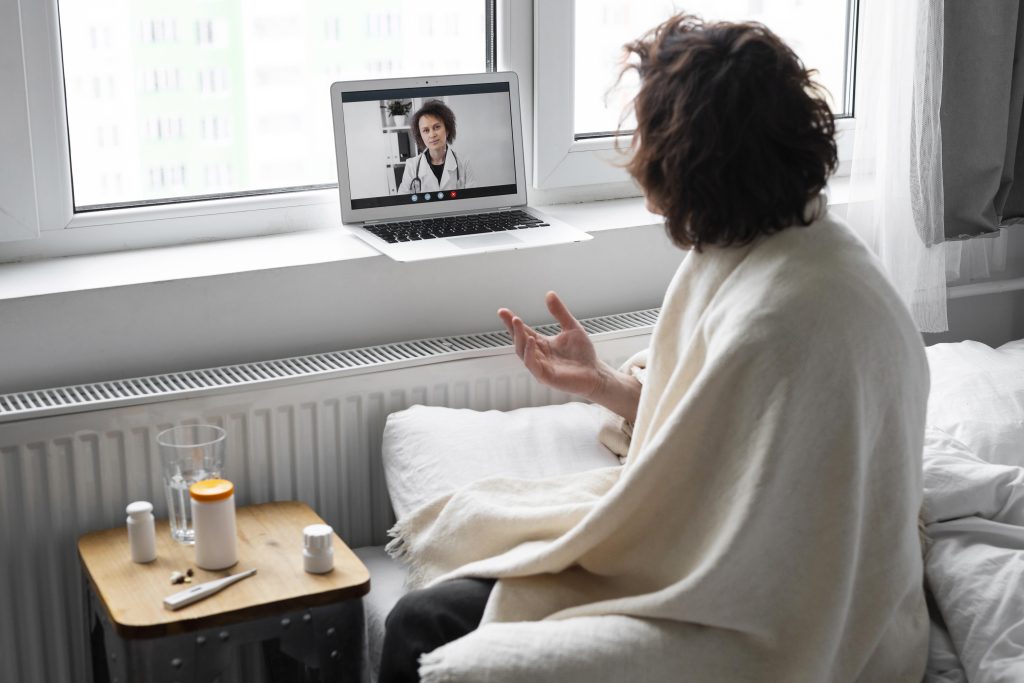This guide will walk you through exactly what is virtual therapy, explore the types available, how it works, and what it typically costs.
What Is Virtual Therapy?

At its core, virtual therapy refers to psychological counseling or psychotherapy that’s delivered through technology instead of traditional in-person sessions. Think video calls, secure messaging apps, or even phone calls where licensed professionals provide structured therapy from afar.
It’s important to distinguish virtual therapy from general online wellness advice, mental health blogs, or peer-support forums. With virtual therapy, you’re working directly with trained and licensed professionals using recognized therapeutic methods.
The demand for virtual therapy surged during the COVID-19 pandemic when lockdowns made traditional therapy difficult. Platforms like BetterHelp, Talkspace, and even individual provider portals saw explosive growth, making therapy more approachable and scalable than ever before.
How Does Virtual Therapy Work?
The process of starting virtual therapy is easier than you might think. Here’s a step-by-step breakdown:
- Sign Up and Create an Account – Most platforms will prompt you to fill out basic information and preferences for the kind of support you’re looking for.
- Complete Intake Forms – These typically include your mental health history, symptoms, and goals. This helps match you with a suitable therapist.
- Choose Your Therapist – Some platforms assign one automatically, while others let you browse profiles.
- Schedule Your Session – Once matched, you can book sessions based on mutual availability.
- Use Communication Tools – Sessions might be held via video chat, phone, or secure messaging, depending on what works best for you.
Many services adhere to strict privacy standards like HIPAA compliance and end-to-end encryption to ensure your information stays confidential.
Curious about other forms of virtual healthcare? Here’s a quick tangent of how do virtual doctor visits work: much like virtual therapy, these involve scheduling, secure video platforms, and real-time conversations, only with medical doctors instead of therapists.
Types of Virtual Therapy
Virtual therapy isn’t one-size-fits-all. Depending on your comfort level and needs, different formats are available.
Video-Based Counseling
The most similar to in-person therapy, using Zoom-like platforms.
Text/Message-Based Therapy
Communicate with your therapist through a secure chat system, often asynchronously.
Audio-Only Sessions
Great for people with limited bandwidth or camera access.
App-Based Tools
These include mood tracking, journaling, guided meditations, and AI support that complement therapy sessions.
Each format serves different preferences. For example, someone with social anxiety might prefer messaging, while someone dealing with relationship issues may benefit more from live video interaction.
Who Is Virtual Therapy For?
Virtual therapy is incredibly versatile and can help a wide variety of people and challenges, including:
- Mental Health Conditions: Anxiety, depression, PTSD, bipolar disorder
- Chronic Stress: Related to work, finances, or caregiving
- Life Transitions: Grief, divorce, moving, or career changes
- Relationship Struggles: Couples and family counseling
It’s especially beneficial for remote workers and digital nomads, students juggling coursework and mental health, caregivers or parents with tight schedules, and individuals in rural areas with limited access to therapists.
Benefits of Virtual Therapy
Why are so many people turning to virtual therapy? Here are some compelling reasons:
Accessibility
No need to commute or live near a therapist’s office.
Flexibility
Sessions can be scheduled during lunch breaks or late at night.
Lower Cost
Often more affordable than in-person sessions.
Anonymity
Great for those who feel uneasy about being seen entering a therapy office.
More Choices
You’re not limited to local therapists and can find a specialist who truly meets your needs.
Limitations of Virtual Therapy
While virtual therapy has many advantages, it’s not perfect for every situation. Here are some scenarios where in-person care might be more effective:
- Severe Mental Illness – Conditions that require close monitoring or medical intervention.
- Emergencies or Crises – Suicidal thoughts or psychiatric emergencies demand immediate, in-person support.
- Technology Barriers – Poor internet connection or lack of a private space at home.
- Insurance Gaps – Some regions or plans still don’t fully cover virtual therapy.
What Conditions Can Be Treated Virtually?
Virtual therapy can effectively address many issues:
- Common Mental Health Issues: Depression, anxiety, phobias, mood disorders
- Stress-Related Conditions: Burnout, sleep problems, adjustment disorders
- Relationship Dynamics: Marriage counseling, co-parenting, family communication
- Life Events: Loss of a loved one, job changes, chronic illness diagnoses
So, if you’re wondering whether virtual therapy is “real” therapy, it absolutely is. It uses evidence-based methods just like face-to-face counseling.
How Much Does Virtual Therapy Cost?
Pricing for virtual therapy varies, but it tends to be more budget-friendly than traditional therapy.
Subscription Models
Services like BetterHelp or Talkspace offer weekly or monthly plans starting around $60–$90/week.
Per Session Fees
Independent therapists or provider platforms may charge $80–$200 per session.
Tiered Plans
Some platforms offer tiered packages based on how many sessions or features you want.
Many insurance plans cover virtual therapy, but the details vary. Some may require a copay, while others reimburse after the fact. Be sure to check with your provider. Also, some platforms offer financial aid or sliding-scale fees, making therapy more affordable for lower-income users.
Platforms and providers have also adjusted their systems to support telemedicine payment processing, ensuring secure, fast, and compliant billing.
Is Virtual Therapy Safe and Confidential?
Absolutely, but with caveats. Reputable platforms take user privacy and data protection very seriously.
- Encryption & Compliance: Platforms should be HIPAA-compliant and use encryption to protect session data.
- Verified Therapists: Always ensure your therapist is licensed in your state or country.
- User Tips: Use a private room, strong passwords, and avoid public Wi-Fi when accessing sessions.
Many therapists undergo continuing education to ensure they’re trained in delivering effective care online.
Future of Virtual Therapy

Virtual therapy isn’t just a temporary solution, it’s shaping the future of mental health care. Exciting developments in the field include:
- AI-Driven Support: Chatbots and smart apps can handle light emotional support, check-ins, and journaling.
- Immersive Care: Innovations in what is virtual reality therapy are helping users confront phobias, PTSD, and anxiety in safe, simulated environments.
- Mainstream Integration: Virtual therapy is now being integrated into workplace wellness programs, school systems, and public healthcare.
- New Models: Blended models combining in-person and virtual care are emerging, creating more options and flexibility.
You might also ask about what is virtual physical therapy, another niche of remote healthcare helping people recover from injuries with guided virtual exercises.
Frequently Asked Questions (FAQs)
What is the difference between virtual therapy and teletherapy?
Both terms are often used interchangeably, though “teletherapy” sometimes refers more broadly to therapy over any distance-based tech.
Can I get a prescription from a virtual therapy provider?
Not usually. Therapy providers typically do not prescribe, but they may coordinate with psychiatrists who can.
How effective is virtual therapy compared to in-person therapy?
Studies suggest it’s equally effective for many conditions, especially when sessions are consistent and provider-patient match is strong.
What is virtual physical therapy?
A different type of care involving guided physical rehab via video, focused on mobility, pain relief, and recovery support.
How do I pay for virtual therapy?
Payment is typically handled via credit/debit cards or health savings accounts; some platforms integrate telemedicine payment processing systems.
References
1. National Institute of Mental Health. What is telemental health? Retrieved from https://www.nimh.nih.gov/health/publications/what-is-telemental-health
2. U.S. Department of Health & Human Services. Individual teletherapy: Telehealth for behavioral health Retrieved from https://telehealth.hhs.gov/providers/best-practice-guides/telehealth-for-behavioral-health/individual-teletherapy
3. American Psychological Association. What you need to know before choosing online therapy Retrieved from https://www.apa.org/topics/telehealth/online-therapy
4. Psychology.org. Virtual Therapy Vs. In‑Person Therapy Retrieved from https://www.psychology.org/resources/virtual-therapy-vs-in-person/
5. Medical News Today. Virtual therapy: Types, uses, and cost Retrieved from https://www.medicalnewstoday.com/articles/virtual-therapy

Leave a Reply